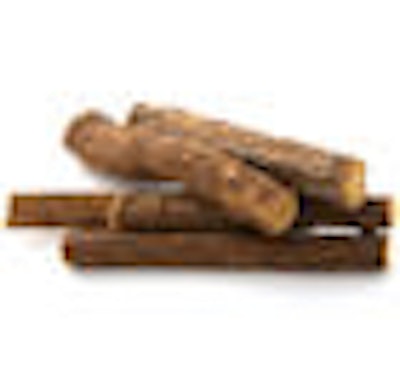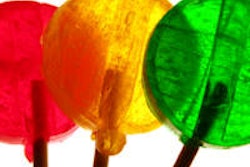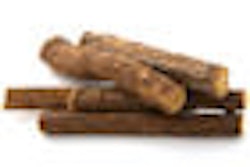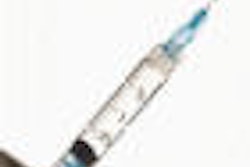
Can a medicinal root that tastes like candy be used to prevent caries and treat drug-resistant thrush? What about helping to treat alveolar bone loss in periodontal disease?
Maybe if it's licorice root. Recent research suggests that licorice extracts and licorice bioactive ingredients such as glycyrrhizin, glabridin, licoricidin, licochalcone A, and licorisoflavan A have potential beneficial effects on common oral diseases, according to a literature review in Oral Diseases (August 18, 2011).
Although many people associate licorice with a flavor, many licorice-flavored foods are actually flavored with extracts of anise seed or fennel seed. Licorice root itself is a sweet, woody root with a yellow pulp, harvested from a couple of species from the Glycyrrhiza genus: G. glabra and G. uralensis.
In recent years, licorice compounds have been studied for their potentially beneficial effects in the treatment of cancer, atherosclerosis, gastric ulcers, hepatitis, bacterial infections, immunodeficiency, and oral disease, according to the Oral Diseases review authors.
"Hundreds of studies have brought evidence that licorice and purified molecules from licorice may have beneficial effects for various aspects of human health," study co-author Daniel Grenier, PhD, the director of the Research Group in Oral Ecology at Laval University, told DrBicuspid.com. "However, as for other natural compounds, it is not a miracle material and taking it in excess cannot solve all problems."
While the anticariogenic properties of licorice have been suggested for more than 30 years, few studies on this aspect have been published, according to Grenier and his colleagues. Some pilot clinical studies have been performed on glycyrrhizin -- the sweet component of licorice root -- with limited results. For example, a 1989 spit-mouth study on 21 subjects found that glycyrrhizin had a tendency toward a statistically significant effect for controlling dental plaque formation after just a few days (Israel Journal of Dental Sciences, November 1989, Vol. 2:3, pp. 153-157). However, another pilot study involving 40 subjects showed that toothbrushing for up to 42 days with a toothpaste containing glycyrrhizin had no effect on the plaque index compared with using a control toothpaste (Journal of Clinical Periodontology, March 1991, Vol. 18:3, pp. 210-212).
"Based on the above studies, it appears that glycyrrhizin, at concentrations and exposure times tested, offers few [sic] potential for caries control," Grenier and his co-authors wrote. "Further randomized, controlled trials are required prior to recommending for or against the use of glycyrrhizin in oral hygiene products."
Other compounds fare better
Other studies have found that some compounds in G. uralensis inhibit the growth of the cariogenic bacterium Staphylococcus mutans (Journal of Natural Products, January 2006, Vol. 69:1, pp. 121-124). Based on these findings, the research team from the University of California, Los Angeles (UCLA) prepared a licorice extract enriched with glycyrrhizol A and developed a sugar-free, licorice-containing lollipop as a potential anticaries product.
 Researchers from the University of California, Los Angeles (UCLA) developed sugar-free, licorice-containing lollipops as a potential anticaries product. The lollipops are commercially available through Dr. John's Candy. Image courtesy of Wenyuan Shi, UCLA.
Researchers from the University of California, Los Angeles (UCLA) developed sugar-free, licorice-containing lollipops as a potential anticaries product. The lollipops are commercially available through Dr. John's Candy. Image courtesy of Wenyuan Shi, UCLA.
Subsequent pilot studies indicated that a 10-day use (twice daily) of the lollipops led to "a marked reduction" of salivary S. mutans (European Archives of Paediatric Dentistry, December 2010, Vol. 11:6, pp. 274-278; International Journal of Oral Science, January 2011, Vol. 3:1, pp. 13-20).
The lollipops are now commercially available through Dr. John's Candy. Each lollipop has 20 mg of licorice extract that includes the glycyrrhizol A compound developed at UCLA, according to Wenyuan Shi, PhD, the chairman of oral biology at the UCLA School of Dentistry and one of the researchers involved in developing the compound.
The lollipops are "a new way to combat tooth decay, especially for the ones who cannot correct their sugar-eating behaviors," Shi told DrBicuspid.com. "The killing kinetics is about five minutes, and it takes five to 10 minutes to melt a lollipop."
Dr. John's claims that a 10-day regimen of the lollipops, used as directed, will significantly reduce S. mutans in the mouth for three to six months. However, Grenier and his co-authors caution that there can be adverse side effects if the product is overused.
"Further studies on licorice-containing lollipops need to demonstrate an anticavity effect clinically rather than just a modification of the oral microflora," they wrote. "While the above licorice lollipops may represent attractive anticaries products for high-risk children and the elderly, users should be well-informed about the potential adverse effects, such as hypertension associated with excessive or prolonged use of such lollipops."
Periodontal disease, candidiasis, ulcers
Additional studies have indicated that licorice compounds may be effective in treating periodontal disease and other soft-tissue conditions, according to Grenier and his colleagues.
For example, "although no human clinical trials have been carried out, in vitro studies have brought evidence that licorice and its bioactive ingredients may represent potential phytochemicals for the development of a new natural therapy to treat or prevent periodontitis," they wrote.
A crude extract from G. uralensis was found to suppress both the growth and formation of biofilm formation by Porphyromonas gingivalis (Journal of Dental Research, 2008, Vol. 87:special issue B), while licoricidin and licorisoflavan A have been shown to have anti-inflammatory effects (Journal of Periodontology, January 2011, Vol. 82:1, pp. 122-128).
Other research has shown glabridin to stimulate osteoblasts, possibly indicating a promising treatment for the alveolar bone loss found in severe periodontal disease, the researchers added (Biochemical Pharmacology, August 1, 2005, Vol. 70:3, pp. 363-368).
"It suggests that if this molecule could be incorporated into a gel or fiber installed in the diseased periodontal pocket allowing a constant slow release, it could have a positive impact on alveolar bone," Grenier said.
Meanwhile, although few studies have investigated the effect of licorice on Candida albicans -- the most common form of candida -- "findings suggest that licochalcone A and glabridin show promise as therapeutic agents for treating oral C. albicans infections," Grenier and his colleagues wrote.
For example, there have been reports of G. glabra having an antifungal effect on C. albicans (Journal of Ethnopharmacology, June 2003, Vol. 86:2-3, pp. 235-241), and an in vitro study showed that glabridin has potent activity against amphotericin B-resistant strains of C. albicans (Phytotherapy Research, August 2009, Vol. 23:8, pp. 1190-1193).
More recently, Grenier and Céline Messier, one of his co-authors on the Oral Diseases paper, investigated the effects of two licorice extracts (licochalcone A and glabridin) on C. albicans and found that both acted in synergy with nystatin to inhibit the growth of C. albicans (Mycoses, May 25, 2011).
"Phytochemicals are structurally different from classic microbially derived antibiotics; therefore, there are few chances that pathogens demonstrate resistance," Grenier said.
Finally, the research surrounding the effectiveness of licorice in treating recurrent aphthous ulcers has been so far been mixed. A randomized, double-blind clinical trial observed a dissolving oral patch containing a licorice extract (glycyrrhiza) for up to eight days to improve ulcer size and pain compared with a placebo patch (General Dentistry, March-April 2008, Vol. 56:2, pp. 206-210).
However, a 2009 study that investigated the efficacy of licorice bioadhesive hydrogel patches to promote healing and pain relief found that the control patches -- which did not contain licorice -- were equally effective in reducing pain and promoting healing (Phytotherapy Research, February 2009, Vol. 23:2, pp. 246-250).
Additional research is needed in this area before any conclusions can be made about the benefits of licorice in treating recurrent aphthous ulcers, Grenier and his co-authors noted.
"Licorice extracts and licorice constituents incorporated into oral hygiene products such as mouthwash, toothpaste, gel, and chewing gum need to be further investigated in clinical studies in order to validate the beneficial effects observed in in vitro assays," they concluded.



















